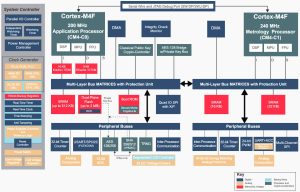The processors, nominally the PIC32CXMT family, have one or two Arm Cortex-M4F cores – all get a 200MHz application processor, and some get a 240MHz metrology processing core.
The PIC32CXMTSH version in particular (see diagram) gets an ‘energy metering analogue front-end’ (EMAFE) as well, which supports single and dual-phase meters, is compliant with electricity metering standards up to class 0.2 (ANSI C12.20-2002 and IEC 62053-22), and works with the company’s DSP metrology DSP library which is compliant with the same two standards.
This block has five 24bit (102dB dynamic range) ΔΣ ADC measurement channels, and the current channels can support sensing via resistive shunt, current transformer or Rogowski coil without external active components. One of the current channels is assigned to neutral conductor measurement for temper detection.
The voltage reference has a typical drift of 10ppm/°C, said Microchip, “with software correction using factory programmed calibration registers”.
A dedicated 2.8V LDO (3 to 3.6V operation, <2.5mW/channel at 3.3V) cleans the front-end’s power supply.
PIC32CXMTC gets dual cores but no EMAFE, and the PIC32CXMTG only gets one core and no analogue front-end.
Amongst the family, security features in spades: with secure boot and secure key storage coupled with cryptographic and hash hardware acceleration for ECC, RSA, AES128/256 and SHA256/512. An execute-in-place QSPI interface with on-the-fly AES128 encryption is included for future-proofing – memory expansion or changing system requirements.
Also across the family is a segment-style LCD controller, memory protection, I2C, SPI, UART (USART), PWMs, general-purpose 32-bit timers, a 12bit ADC, analogue comparators and a battery backed 1 μA real-time clock.
Modem IC
MPL460 is the power-line modem IC for narrow-band protocols under 500kHz, ITU G.9903 (G3-PLC) and ITU G.9904 (PRIME) included. It has been designed to comply with FCC, ARIB, KN60 and CENELEC EN50065 regulations.
It interfaces with its host microcontroller through a four-wire SP bus, and the signal injection line driver is Class-D to reduce consumption and heat dissipation.
It also has a CPU on-board, woth dedicated power-line coms hardware acceleration.
For security, there is secure boot, AES-128 CMAC for authentication and AES-128 CBC for decryption, as well as fuse programming for decryption and authentication 128-bit keys.
it comes in a 10 x 10mm TFBGA-81, and works over -40 to +85ºC.

